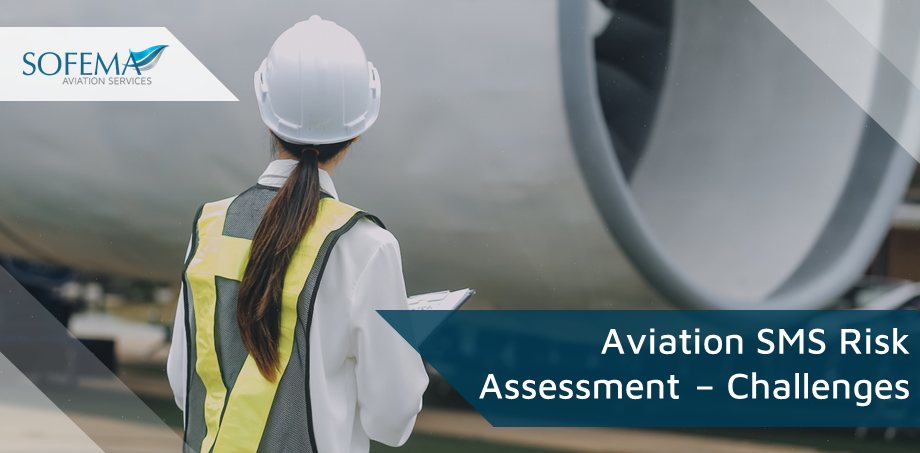Sofema Aviation Services (SAS) considers key challenges faced by the Safety Managment System.
Introduction
While Aviation Safety managment System risk assessment faces challenges such as inconsistent hazard identification, organizational barriers, and resource constraints, the adoption of best practices and practical training can bridge these gaps.
Leadership must prioritize SMS integration into the organizational culture and ensure ongoing support for safety initiatives.
Generic Issues
Lack of awareness training for the AOC, AMO, CAMO – In these times of a complex and integrated regulatory environment it is important that employees have an appropriate level of role specific understanding of how the regulatory environment interacts.
No preparation or documented plan – Many Companies under resource the Safety Management System and as a result “disconnects” appear and any weakness in the implementation plan are magnified.
No monitoring of timeframe, “milestone” target dates – Aviation Safety Management System is a top down system and it is essential that the implementation is achieved with the hands on oversight of the leadership team.
Safety Risk Assessment is a term used to describe the overall process or method where you:
- Identify hazards and risk factors that have the potential to cause harm (hazard identification).
- Determine appropriate ways to eliminate the hazard, or control the risk when the hazard cannot be eliminated (risk control).
Remember that a Hazard is anything which has potential to cause Harm!
Remember that Risk is a Measure of how exposed we are to a particular Hazard!
Detailed Issues:
Difficulty in Identifying Hazards – Identifying hazards, especially latent hazards, remains a significant challenge.
- Employees may lack awareness or training to report hazards effectively.
- Organizations often overlook hazards that result from procedural errors, time pressures, or human fatigue.
Inconsistent Risk Analysis Processes – Inconsistent methodologies or failure to apply standardized risk assessment frameworks (e.g., bow-tie analysis, fault tree analysis) leads to unreliable results.
- Poor risk analysis may result in prioritizing the wrong hazards or missing critical safety threats.
Organizational Culture – A “blame culture” discourages employees from reporting hazards, limiting proactive identification of risks.
- Fear of repercussions prevents open communication about near misses or unsafe conditions.
Lack of Data Integration and Tools – Effective risk analysis relies on comprehensive data collection and integration across departments.
- Smaller organizations may not have access to advanced safety management tools or data analytics capabilities.
Resource Constraints – Adequate manpower, training, and financial resources are required for effective SMS implementation, which some organizations find challenging.
Best Practices for Hazard Identification and Risk Analysis
- Adopt Systematic Approaches – Use tools like brainstorming sessions, safety surveys, and workshops to identify hazards proactively.
- Utilize Historical Data – Incident/accident databases, internal reports, and trend analysis can help uncover recurring hazards.
- Standardized Risk Analysis Methods – Use consistent frameworks such as:
o Risk Matrices (5×5 matrices for severity and likelihood)
o Bow-Tie Analysis to visualize causes and consequences
o Fault Tree Analysis for system-level failures
Promoting a Positive Safety Culture
- Implement “just culture” policies that encourage hazard reporting without fear of punishment.
- Provide regular training to reinforce Aviation SMS principles.
Data-Driven Insights
- Integrate data analytics to identify patterns, trends, and root causes efficiently.
Continuous Training and Competency Development – Focus Areas
Develop more detailed guidance material on SMS implementation, particularly on hazard identification methodologies and risk analysis techniques.
- Risk assessment techniques
- Hazard recognition skills
- Use of SMS tools and software
Next Steps
Follow this link to our Library to find & download related documents for Free.
Sofema Aviation Services and Sofema Online provide classroom, webinar and online training – see the following example course https://sassofia.com/course/sms-hazard-identification-risk-assessment-1-day/
For comments & questions please email team@sassofia.com
Tags:
CAMO, SMS Risk Assessment, Hazard Identification, Risk Analysis, AOC, Leadership, AMO, SAS blogs, Risk Control, Positive Safety Culture





